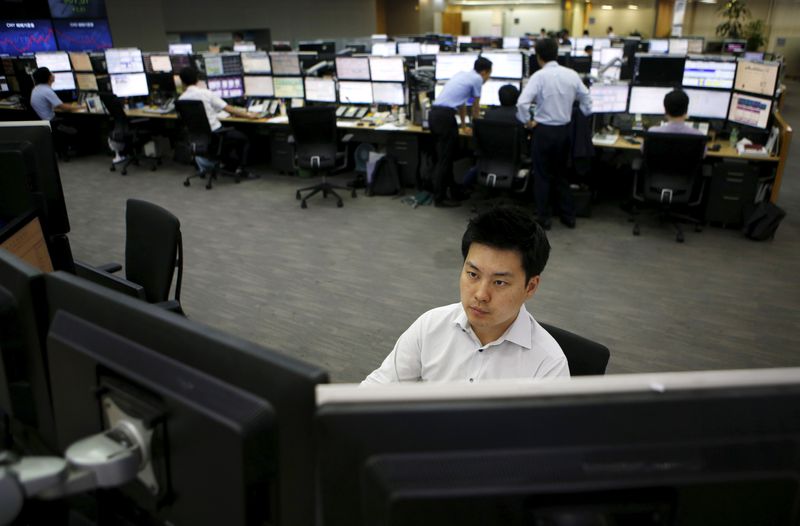 © Reuters. A currency dealer works at a dealing room of a bank in Seoul, South Korea, August 25, 2015. REUTERS/Kim Hong-Ji
© Reuters. A currency dealer works at a dealing room of a bank in Seoul, South Korea, August 25, 2015. REUTERS/Kim Hong-Ji
By Alun John
HONG KONG (Reuters) - Asian shares edged higher on Wednesday from close to two-year lows hit in the previous session and the dollar held steady, ahead of keenly awaited U.S. inflation data that will offer a guide to how aggressively the U.S. Fed will raise rates.
MSCI's broadest index of Asia-Pacific shares outside Japan rose 0.45%, trading marginally above its lowest level since July 2020 touched the day before. Japan's Nikkei gained 0.3%.
Chinese blue chips led the gains, rising 1.5% after producer prices in the world's second largest economy rose at the slowest pace in a year in April, leaving room for more stimulus to shore up an economy facing pressure from COVID-19 restrictions.
Strict curbs to combat the coronavirus have weighed on China's economy. As of Tuesday, 41 Chinese cities are currently implementing full or partial lockdowns or some kind of district-based control measures, estimates by Nomura analysts showed.
They estimated around 289.8 million people are currently affected by these lockdown measures in regions that account for around 33.8 trillion yuan ($5.02 trillion) of China's total GDP, down moderately from last week’s 327.9 million people and 35.4 trillion yuan.
But the main scheduled event for the day is the U.S. inflation data, due at 12.30 GMT, which will give an indication of whether the U.S. Federal Reserve will raise rates even more aggressively to combat inflation.
The Fed last week raised its target for overnight bank-to-bank lending by a half a percentage point, and Chair Jerome Powell said two more such rate hikes are likely at the U.S. central bank's coming policy meetings.
There has also been speculation in markets they the Fed will need to go in for a massive 75 basis point hike at one meeting.
This has sent U.S. Treasury yields higher, and supported the dollar.
"A positive surprise (in CPI data) will encourage markets to increase pricing for a 75pt increase in the Funds rate later in the year and support the dollar, while a negative surprise will keep pricing for 50bp increases in June and July intact and leave the dollar steady," said CBA analysts in a note.
Analysts expect the U.S. consumer price index to show a sharp pullback in monthly growth, cooling to 0.2% in April from 1.2% in March.
They also predict an annual increase of 8.1%, 0.4 percentage point lower than the prior 8.5%, which was the hottest reading since December 1981.
The dollar index, which measures the greenback against six main peers, was steady at 103.86, not far from the high of 104.49 reached at the start of the week for the first time since December 2002.
Wall Street was mixed overnight. The Nasdaq rose 0.98% and the S&P 500 gained 0.25% but the Dow Jones Industrial Average fell 0.26%.
U.S. Treasuries were also quiet ahead of the data. The benchmark 10-year note yield was steady at 2.9869%, having fallen overnight from a three-year high.
On the front end of the curve, the U.S. two-year yield, which often reflects the Fed rate outlook, was little changed at 2.68%
Bitcoin was trading around $31,400 having staged a small recovery after falling below $30,000 on Tuesday for the first time since July 2021.
Oil bounced back from declines the previous day.
U.S. crude rose 1% to $100.03 a barrel, having fallen below $100 on Tuesday for the first time this month. Brent rose 1.1% to $103.58.
Spot gold fell 0.1% to $1836.6 an ounce.
($1 = 6.7338 yuan)

